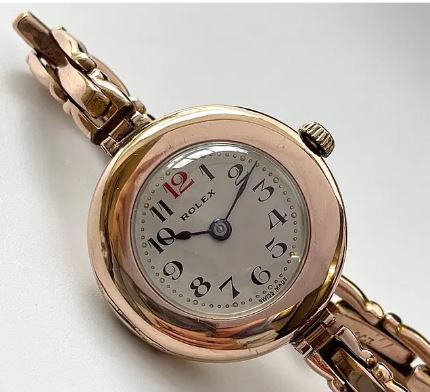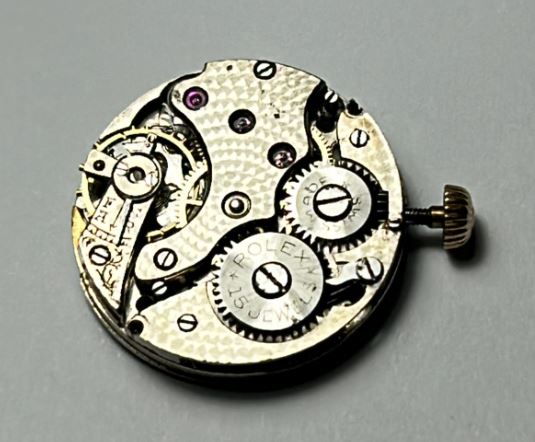Last updated on November 3, 2025
We recently wrote a post about the world of ladies’ antique watches, which are sadly undervalued compared to men’s watches. This is partly due to the prevailing thoughts in years gone by that ladies’ watches were more a piece of jewellery than a serious timekeeping tool. However, we recently came across this Rolex 9ct Rose Gold ladies wristwatch, dating from 1920, which largely defeats that argument. It is well-made and very elegant, but has also proven to be a reliable timekeeper.
A brief history of Rolex
Rolex was originally established in 1905 in London, England, by Hans Wilsdorf and his brother-in-law, Alfred Davis. They traded under the name Wilsdorf and Davis. According to Mikrolisk, the company registered Rolex as its official brand name in 1908. By 1915, the company had changed its name to Rolex Watch Co. Ltd. This rebranding may have been influenced by growing anti-German sentiment in Britain during World War I, as the name “Wilsdorf” sounded distinctly German (Rolex at Grail Watch Wiki).
In its early years, Wilsdorf and Davis primarily focused on importing Swiss watch movements into England. They fitted them into cases manufactured by Dennison and other suppliers. These watches were then sold to retail jewellers, who often placed their own brand names on the dials. The earliest timepieces from the company can typically be identified by the hallmark “W&D” stamped on the inside of the case back.
The style of early 1920s Rolex ladies’ wristwatches was heavily influenced by the prevailing Art Deco movement. They emphasise elegance, delicate proportions, and geometric forms. “Cocktail watches,” such as this example, were small and stylish, reflecting the perception of wristwatches as more feminine items at the time. They housed small, manually-wound movements, from makers such as Aegler (Rebberg).
When this watch was produced, just two years after the end of WW1, the landscape of the luxury watch industry was completely different. Timepieces of this kind were not mass-produced accessories for the middle class. Rather exclusive creations made in limited numbers for a privileged few. This was at a time when the average person could scarcely imagine owning such a luxury.
Original silvered dial
The completely original silvered dial remains in remarkably well-preserved, near-mint condition. This is precisely the type of dial that appeals to serious collectors and investors. Examples in such superb condition are found on only a small number of surviving watches from the period. The uppercase “Rolex” signature is sharp and well-defined. The elegant Arabic numerals perfectly capture the aesthetic of Rolex designs from the post–World War I era. The original blued steel spade hands are correct for this period and remain in exceptional condition, as does the distinctive winding crown (Blue steel at wikiHow).
Case
The case has the expected full set of British hallmarks, including London, 9 carat Rose gold, 1920 and the correct W&D sponsors mark of Wilsdorf & Davis, the founding partners of the Rolex brand. The 9ct Rose gold expanding bracelet suits a wrist size of 145mm to 200mm. The overall dimensions of the watch case are a diameter of 27mm with a length including case lugs of 32mm. The case is in outstanding, near-mint condition, showing no notable dents or scratches across its surface. On very close inspection, a few minute marks from gentle, careful use may be visible. However, these are entirely typical of a well-preserved antique watch, Rolex or otherwise, and are of no concern whatsoever.
This case clearly draws inspiration from the pocket watch designs of the earlier Edwardian era. The hinged case back, rather than press‑fit, reflects this influence beautifully. At the time, this tiny hinge would have been carefully soldered by hand, making it a very delicate component. Any past damage can be difficult to repair today, and finding a skilled craftsman capable of restoring it to its original standard is becoming rare.
Rose gold
Pure gold is naturally soft and dense, so it is often alloyed with other metals to increase its strength. These combinations also produce various colours and types of gold. For example, rose gold is created by blending gold with copper, giving it its distinctive pink hue. Typically, rose gold consists of about 75% gold and 25% copper, a mixture that enhances both its durability and colour.
Rose gold jewellery first appeared in Russia in the early 1800s, where it was known as “Russian gold.” It gained prominence when Carl Fabergé used it in his luxurious Fabergé eggs. The metal enjoyed further popularity in Britain during the Victorian era and experienced a global resurgence during the Art Deco period of the 1920s.
Rebberg movement
Many assume that Rolex made their own movements in these early watches, but this was not technically true.
The most significant movement used by Rolex was the “Rebberg” calibre. This was named after the street in Bienne, Switzerland, where its maker, the Jean Aegler Company, was based. This movement allowed Rolex to dominate the growing wristwatch market during the First World War. According to Mikrolisk, the Rebberg trade name was registered by Aegler in 1903. Notably, Rebberg earned a prestigious “Class A” accuracy certificate from London’s Kew Teddington Observatory in 1914 (Rolex & Aegler at Bob’s Watches).
The Rebberg movement is in very good condition. It is manually wound and features engine-turned pearling across its entire top surface. The movement is clearly signed “Rolex, 15 Jewels, Swiss Made”. This is the side of the movement that would have been readily visible, and this is where Rolex would have insisted its name appear. Rolex offered the Rebberg in two grades: a seven-jewel entry version and a deluxe fifteen-jewel model. Both were well-constructed. However, the fifteen-jewel version received finer finishing, with its ornate engine-turned bridges replacing the polished plates of the basic model.
A Swiss modèle déposé had a term of five years, after which it could be renewed. Otherwise, it would be automatically struck off the list. Only three renewals were allowed by Swiss law. Therefore, a modèle depose could effectively be solely a company for a maximum of five years. I couldn’t find any specific online reference to the 6430.
Fine Times Watches
The watch had been purchased by one of our regular contributors as a birthday gift. It was bought from Fine Times Watches Est. 1947 on Etsy. The owner, Alan, was absolutely brilliant. He responded promptly to all Etsy messages and made the whole experience effortless. The watch arrived beautifully packaged, in immaculate condition, and matched the description and pictures perfectly. It fit perfectly and even arrived ahead of schedule, which was a huge plus as it was a special birthday gift.
One of the standout reasons to buy from Fine Times Watches is that an MBHI-certified watchmaker services all their timepieces before dispatch. That level of care and expertise is rare these days. Servicing a mechanical watch properly takes real skill, time, and dedication. The one-year guarantee provides added peace of mind, and the overall service was truly first class.
Summary
The watch was serviced by an MBHI-certified watchmaker and is running reliably and accurately for an antique piece. Timekeeping is more than acceptable at less than one minute slow over 24 hours. The power reserve is in excess of 24 hours. This is more than acceptable for a watch that will likely only be worn on special occasions.
This early ladies’ Rolex offers exceptional appeal to collectors due to its remarkable originality. The untouched dial, blued-steel hands, original movement, and rare expanding bracelet create an authentic presentation. An original rose-gold bracelet from this era is highly unusual and greatly enhances its wearability. Similar watches from the period could have lost their bracelets over time, making this complete example especially desirable and collectable. Hallmarked London 1920, it represents an early Rolex wristwatch for women, produced when wristwatches were still a novelty.
Crafted in 9-carat rose gold, it stands apart from the more common yellow-gold or steel models that followed. Rolex remains one of the most coveted names in watch collecting, and early gold pieces like this are increasingly scarce. The movement performs admirably, running within one minute over twenty-four hours, with a reserve exceeding a full day. While now probably best suited for occasional wear, its beauty, originality, and historical significance make it a distinguished collector’s piece.



